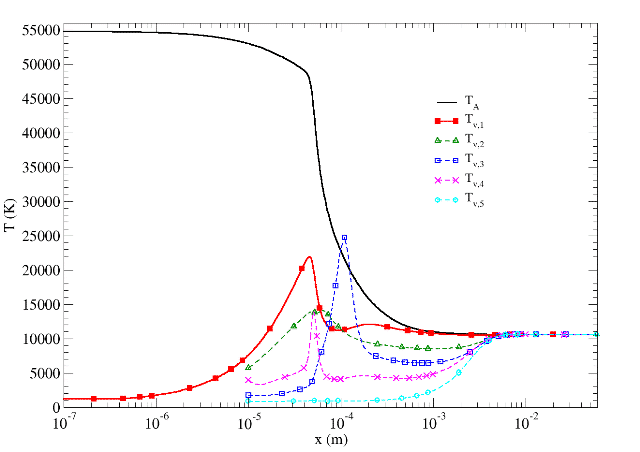The present work is a first step in computing a reactive gas flow behind a shock wave with detailed collision-radiative models. If simulating high-temperature, high-enthalpy, non-equilibrium gas flows in shock layers has been widely done so far with global models for the chemical kinetics and the vibrational non-equilibrium, it is quite new to compute such flow fields with detailed chemistry models. This is now possible as the computational and memory resources of the computers allow to run CFD codes with detailed models. State-specific vibrational models are efficient to model both the chemical reactions and the vibrational non-equilibrium at once, without making strong assumptions (like Boltzmann distribution) as it it the case with multi-temperature models for vibrational non-equilibrium modeling.
A very first step has already been done by CORIA in simulating the reactions between chemical species on their vibrational excited states and the evolution of these pseudo-species (chemical species on various vibrational states) through a normal shock wave resolved with a one-dimension Rankine-Hugoniot solver, by means of one of their detailed collisional-radiative model, CoRaN2N (see Refs. AnnaloroBultelOmaly-2014-JTHT, BultelAnnaloroDruguet-2014-EPJ).
This model is going to be implemented in the CFD code PINENS developed at IUSTI, in which the shock resolution is done with a shock capturing method (approximate Riemann solver in a finite volume discretization of the Navier-Stokes equations).
Results already obtained by CORIA with one-dimension Rankine-Hugoniot simulations are the space evolution of the flow temperature and the different vibrational temperatures TV1 to TV5 of the electronic ground state of N2 behind the shock wave

The expected results to be presented at the symposium are the evolution of these species on their vibrational excited states in a two-dimension shock layer flow resolved by the PINENS code.
Comparisons between results obtained with detailed models and results obtained with global models will also be presented, to show how the global models perform compared to the detailed models in the prediction of the chemical species and vibrational states evolution past a shock wave.
References
J. Annaloro, A. Bultel. P. Omaly,
Collisional-Radiative Modeling Behind Shock Waves in Nitrogen,
Journal of Thermophysics and Heat Transfer, DOI: 10.2514/1.T4263.
A. Bultel, J. Annaloro, and M.-C. Druguet,
Dissociative Recombination in Reactive Flows Related to Planetary Atmospheric Entries,
to appear in the European Physical Journal Web of Conferences.

